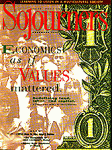Tony Campolo's first book on the environment, How To Rescue the Earth Without Worshipping Nature, beckons the church to take a leadership role in saving the planet. The "how to rescue the Earth" part of the title is an outline of the biblical case for environmental responsibility and charts practical ways churches and individuals may involve themselves in Earth care.
Campolo's approach to the second half of his title, "without worshipping nature," is moderately troublesome. In his attempt to draw the theological distinction between New Age environmental concern and the biblical case for Earth care, his critique is unduly harsh; it undermines his very attempt to bring together large numbers of people to rescue and safeguard our shared environment.
Having gained the attention and respect of mainstream evangelicalism in the United States over the past 15 years, Campolo's fervor for Christian environmentalism is hopeful. He admits, "Studies show that the more zealously committed people become to evangelical churches, the less concerned they are about the horrible things that are happening to the environment."
Campolo is one of the few voices speaking out about the environment to evangelicals who may not be tuned in to contemporary Christian articulations of environmental theology, to the historical example of God speaking to St. Francis of Assisi through animals, or the traditional example of Amish communities and their longstanding linkage of personal faith with farming methods.
To his credit, Campolo brings these and other examples together in his book, shaping a well-rounded theological perspective on care for the Earth. In addition to St. Francis and the Amish, he includes Martin Buber, John Wesley, Pierre Teilhard de Chardin, John Calvin, and the creation theology of the Eastern Orthodox Church.
He challenges evangelicals who oppose abortion to reconsider the environment as the number one pro-life issue of our time:
The major cause of world hunger right now is the destruction of the environment. We are destroying the capacity of the earth to produce the food to feed the world. That makes ecology the ultimate pro-life issue.
I would argue that this also challenges the Christian Left who may consider the threat of nuclear war or the wealthy's exploitation of the poor to be the more prominent "pro-life" or justice issue of our time.
Economic and political initiatives are not all we need in order to bring about restoration of the environment. A fundamental reassessment of what we value and how we perceive success is at the core of Campolo's message to save the environment. Lives inspired by "concern for others and a sensitivity to God's creation" must replace profit-motivated, self-interested, comfort-driven lifestyles if we are to take environmental concern seriously.
Campolo does in this book what he does best and is renown for: challenging the unconverted evangelical to fuse justice issues--in this case the environment--with their personal faith in his persuasive "Campolo unplugged" fashion. This alone makes the book critical, timely, and compelling.
BUT CAMPOLO is mindful of his audience and addresses the perceived threat of the New Age movement to Christianity. The book caters so much to these fears that it often drew my attention away from its principle environmental themes.
In the first chapter, Campolo shares his desire "to help bridge the gap that now exists between many evangelicals and many environmentalists who often tend to view each other with suspicion." Few bridges are built in the depiction of people involved in New Age and other environmental theologies: "Anti-Christian," "off the wall," "strange," "cultic," "seductive," "crazies," "enemies of the faith," and "deviant" were primary descriptions of environmentalists outside of a Christian theological perspective. Such characterizations make hopes for inter-religious dialogue around environmental concerns difficult to imagine.
In his efforts to avert criticism from his primarily evangelical readership (who might associate his environmental concern with New Age theology), his lavish critique of New Age and Native American theology (among others) is counterproductive. As Campolo himself stated at an environmental retreat I attended recently, Christians must not give monologues but instead partake in theological dialogues with those who share with Christians a common concern for the environment.
Campolo's "us and them" tone in this book should be honed to "we together" if he intends to build bridges of understanding among environmental activists. After all, most Christians in the United States started reducing, reusing, recycling, and simplifying lifestyles much later than many of our brothers and sisters who have long practiced reverence for the Earth.
Let's not enter into the environmental movement in fear of losing our religion; let's be confident of what we have to offer and encouraged by what we have to learn from others. Christianity should flavor the environmental movement with faith and hope, not splinter it with name calling and competition for theological leadership.
How To Rescue the Earth Without Worshipping Nature. By Tony Campolo. Thomas Nelson Publishers, 1992. $18.99 (cloth).
Jeff Shriver was a Sojourners magazine editorial staff intern when this article appeared.

Got something to say about what you're reading? We value your feedback!
